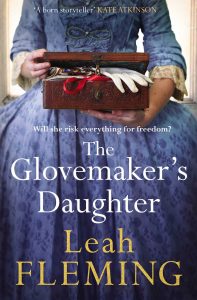The Glovemaker’s Daughter by Leah Fleming Sheds Light on 17th-Century Quakers
 Leah Fleming’s novel The Glovemaker’s Daughter plays with the dual-time and time-slip narrative devices. It opens with a ghostly apparition of a woman in 17th-century dress, and soon a journal is discovered hidden in the walls of a Quaker meeting house in Pennsylvania: the journal of a woman who began her life in an isolated farming community in Yorkshire.
Leah Fleming’s novel The Glovemaker’s Daughter plays with the dual-time and time-slip narrative devices. It opens with a ghostly apparition of a woman in 17th-century dress, and soon a journal is discovered hidden in the walls of a Quaker meeting house in Pennsylvania: the journal of a woman who began her life in an isolated farming community in Yorkshire.
Fleming has built a solid reputation as a historical novelist with a particular focus on telling stories set in the Yorkshire Dales. Many readers will know her powerful tales set in the 19th and 20th century but she has explored the 17th century in previous books. Although The Glovemaker’s Daughter takes place largely within the Quaker communities in Yorkshire in the 17th century, the book’s heroine Joy also travels, along with many others who faced persecution for their religious beliefs, to the settlements in Pennsylvania.
I asked Fleming about her research for the book. “This story grew out of detailed research for our village history book. The fate of Joy’s parents was taken from an actual recorded incident here where a Quaker couple were taken to York Jail for marrying without the consent of the local priest circa 1670. When you are given such a starting point, the story evolves. Its journey took me to Pennsylvania and the Delaware River. I was intrigued by such a powerful period of religious persecution, and reading accounts of the horrific voyage many endured also spurred me on.”
Her upbringing fed into the research for The Glovemaker’s Daughter as well. “Coming myself from a strict religious background, I know how such restrictions affect your early years and can lead to rebellion later. I am lucky to have friends in the Philadelphia area who took me to museums where I was able to follow this interest. It is often hard to break away from a closed community where beliefs are seen as” the only truth”. The early Seekers were tightly bound to their beliefs, dress code, rules and regulations that bear little resemblance to the Society of Friends movement now.”
The book’s heroine Joy is a young woman who questions her faith and her beliefs and who finds it difficult not to rebel against the strictures laid down for her by family, society and religion. Determined as she might be to serve God as faithfully as she can, she also wishes to embrace life. For the author, writing Joy’s story was very personal. “Growing up with the language of the Bible and Shakespeare, Joy’s voice came to me but I had to modify Quaker idioms to suit today’s readers,” Fleming says. “I guess there is a lot of my own experiences in her spiritual journey, my own struggles to break free and form my own beliefs and the sacrifices that this may entail, including guilt at no longer being at one with family and friends.”
The book also offers insight into the relations between the new settlers and the Indigenous peoples they encountered. Having learned about the healing properties of various herbs during her Yorkshire childhood, Joy is quick to appreciate that the Indigenous women of the area would have much knowledge to offer the new settlers. Fleming was delighted to find a wealth of recorded material about this period when she visited the United States. “I visited the Museum of American Native Peoples in Washington and also a very informative little museum of the Lennie – Lenape tribe close to Bethlehem. PA… reading true life records written at the time. Survival depended on gaining practical skills and knowledge from [Indigenous peoples], especially their medicinal treatments, which are well recorded.”
Having lived for a number of years in Yorkshire, Fleming continues to be inspired by the landscape and its rich history. With such richness to draw upon, readers are assured of many more tales to come.
About the contributor: Lisa Redmond is a writer, currently working a novel about 17th-century Scottish witches. She blogs about books, writing and women in history.






